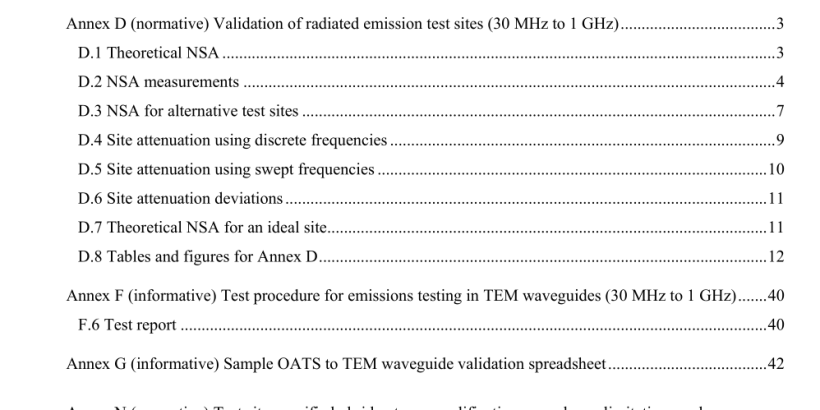ANSI C63.4A-2017 pdf download.American National Standard for Methods of Measurement of Radio- Noise Emissions from Low-Voltage Electrical and Electronic Equipment in the Range of 9 kHz to 40 GHz
NOTE 1—Users are cautioned that the determination of the appropriate GSCF values using the methods described in ANSI C63.5 is a complex undertaking, and that these factors are dependent on the exact type of antenna used. NOTE 2—The theoretical values for GSCF in Annex G of ANSI C63.5-2017 apply only for biconical antennas that comply with the dimensional and other conditions stated within that annex. If such biconical antennas are used for performing NSA measurements at heights that are not covered in that Annex G (e.g., 2.5 m for vertical, and 3 m for horizontal), appropriate GSCF values are determined using the procedure in Annex I of ANSI C63.5-2017. For biconical antennas that differ from the dimensional and other conditions stated in Annex G of ANSI C63.5-2017, and for LPDA antennas and/or hybrid antennas, GSCF values are determined using the procedure in Annex I of ANSI C63.5-2017. Linearly-polarized antennas, with calibrated antenna factors, are required for NSA measurements. Antenna factors shall be calibrated using the Standard Site Method (SSM) specified in ANSI C63.5, and the measurements involved shall be traceable to a national standard. Antennas shall be calibrated as a pair (i.e., transmit antenna and receive antenna shall be calibrated together), in accordance with 4.4.2 of ANSI C63.5-2017. Antenna factors usually account for losses in the balun. If a separate balun or any integrally associated attenuators, or both, are used, their effects shall be included in the antenna calibration results. The receive antenna and the transmit antenna shall be identical (i.e., same manufacturer and model number; or the antenna factors of the individually calibrated antennas shall differ from each other within 1 dB at each calibration frequency), and shall be of the types specified in Table 3 (see 4.5.1 of ANSI C63.4-2014) for use in performing test site validation measurements. The design of a tuned dipole reference antenna is described in ANSI C63.5 (see also the NOTE in 4.5.4 of ANSI C63.4-2014).
For tuned dipoles, Figure D.1 illustrates the horizontal polarization NSA measurement geometry and Figure D.2 illustrates the vertical polarization NSA measurement geometry (assuming that the dipoles are tuned for all frequencies down to 30 MHz; see figures in D.8). The limiting factor of maintaining at least a 25 cm clearance between the reference ground plane and the lower tip of the receive antenna and the transmit antenna is addressed by fixing the transmit antenna height at 2.75 m and restricting the downward travel of the receive antenna. These restrictions are stated explicitly by the lower scan-height limit in Table D.8 (see D.8). For NSA measurements with broadband antennas, the horizontal polarization geometry is also illustrated by Figure D.1. For vertical polarization NSA measurements with broadband antennas, scan height restrictions usually are not required because of the much smaller fixed dimensions of a broadband antenna compared with a tuned dipole, especially between 30 MHz and 80 MHz. Using linearly-polarized broadband antennas allows minimum transmit antenna and receive antenna heights of 1 m (see also N.2 in Annex N of ANSI C63.4-2014 for dimensional restrictions on hybrid antennas). The requirement for a minimum clearance of 25 cm between the reference ground plane and the lower tips of the receive antenna and the transmit antenna also applies for broadband antennas.
NOTE 1—For both the discrete frequency and the swept frequency methods, an impedance mismatch at the output of the signal source or at the input of the EMI receiver or spectrum analyzer may result in cable reflections that could cause errors exceeding the NSA tolerance. This can be avoided by use of padding attenuators of 10 dB, i.e., one at the antenna end of the transmit antenna cable and one at the receiver end of the receive antenna cable, for both V Direct and V Site measurements. Attenuator values of 6 dB are often adequate, and values as low as 3 dB can sometimes be used. NOTE 2—For vertically polarized antennas, it is especially important to maintain cables leaving the antennas in the same horizontal plane as the center of the antenna directly behind the antenna for a minimum distance of 1 m. Use of ferrite beads on both the transmit antenna and the receive antenna cables close to the antennas can help to eliminate common-mode signals that can contribute to measurement errors.ANSI C63.4A-2017 pdf download
